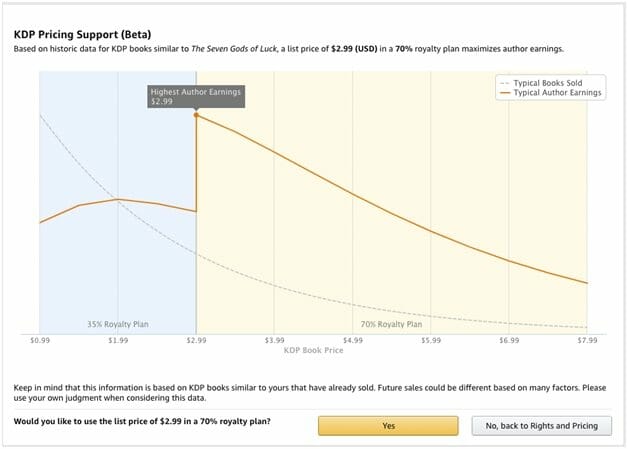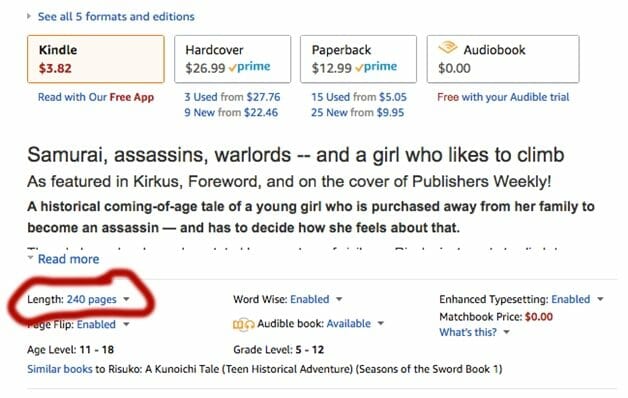By David Kudler
So you’ve finished your book. You cleaned up the text, added optimized images, pulled together all of the front- and back-matter, and created a cover. You converted it into ePub ebook format — either using an app on your computer or online. You’ve made sure the ebook file is valid and meets your standards. You’ve uploaded the file to your first retailer/aggregator and you’ve added all of the metadata, and you’re almost ready to hit PUBLISH, but you’re down to the very last choice…
What price are you going to sell your ebook at?
This question is the cause of more anxious (or panicked) messages and phone calls from clients and friends than any other. So here are six secrets to setting the price for your ebook.
After all, there’s no real basis for a price — no “fixed cost,” unlike a print book, which has per-unit costs to print and ship (and store, etc.). You could name any price you wanted. If you wanted.
So where do we start?
1. Amazon is king
Most of us make the majority of our ebook revenue — 60%–80%+, depending on whom you ask — from one source: Amazon’s Kindle Store. So it makes sense that, when you’re thinking through your price, you might want to start with the ‘Zon.
Now, Amazon has very specific ideas about ebook pricing. When you’re uploading using their KDP platform — or using an aggregator — you can make a very nice 70%-of-retail[i] royalty on all sales between the prices of $2.99 and $9.99.
Price lower than $2.99 or higher than $9.99 and you get a not-so-nice 35% of retail. [ii]
Guess what price most indie authors choose for their titles?
Yeah — actually, a lot choose to go for the 35% rate, and while that can be a good idea sometimes (see #4 below), it’s mostly not.
First of all, hardly anyone buys ebooks priced $1.99. Don’t know why that is, but I’ve learned that the hard way.
And if you price your ebook over $9.99, you need to know that you’re losing money on every sale between $10.00 and $19.99, because you’re making half the royalty — but you’re also killing your sales, because (as I mention in #2 below), ebook prices tend to be fairly elastic — raising the price by a dollar can often lose you more than a dollar in sales.
So unless you’re doing it for a good reason, you want to price your ebook between $2.99 and $9.99.
Now what? How do I narrow my price down?
Well, Amazon has an app for that: their KDP Pricing Support service.
When you get to the final tab in the KDP publishing process — Kindle eBook Pricing — after Amazon tries to lure you into its fools-gold KDP Select program and asks you what territories you hold the distribution rights for (in most cases, “All territories” — unless you’ve licensed some away), there’s a panel titled Royalty and Pricing — the cause of our anxiety. Well, right up at the top of that panel is a button called KDP Pricing Support (Beta).
When you click View Service, Amazon will create a nifty graph that shows your likely sales and revenue at different price points:

This analysis is based on:
- Your ebook’s length
- Your ebook’s genre
As I’ll spell out (see #3 below), those two pieces of information (as well as the size of your platform) will be the biggest determining factors in setting a price for your ebook.
The chart shows both probable sales (the grey dotted line), and probable net revenue (the red line) based on various prices (the numbers along the x-axis at the bottom). [iii]
For this book — my 32-page children’s picture book The Seven Gods of Luck[iv]— the chart suggests that a $2.99 price point would be ideal.
Guess what my usual price for that ebook is. Go on. Guess.
Yeah, $2.99. How’d you guess?
Now, one thing that Amazon is very, very good at is maximizing sales. And since (for ebooks) their profit and your profit are directly tied together, [v] I’ve found that, as a starting point, that service is pretty reliable.
Which isn’t to say that it’s all-knowing.
2. Ebook prices are highly elastic
Sorry to have to dive back into Econ 101. But this won’t be too complicated, I promise. No charts (aside from the one you’ve already seen). No “assume a can opener” gimmickry.
Let’s discuss price elasticity.
If a price change causes an increase or decrease in sales that changes my net royalty (the wonderful bottom line), it’s said to be elastic. So if I’m selling 100 ebooks a month at $1.00 — grossing me $100 — and raising the price to $2.00 sells 20 ebooks — grossing me $40 — then I can say that the price is pretty elastic — that is, it’s very responsive to price changes. A change in the retail price created a larger percentage (negative) change in gross sales.
If on the other hand raising the price from $1.00 to $2.00 sells 90 ebooks — netting me $180 — then I can say that the price is fairly inelastic, meaning that the raise in price barely dented the number of sales, causing my overall revenue to soar.
Following me?
This is reflected by the dotted grey line on the KDP Pricing Support chart above.
As the chart shows, in general ebook prices are fairly elastic. Raising prices (above a certain point) is going to lose you more in gross sales than you’ll make back by increasing the price. And vice-versa.
This means that, often, the ideal price point (according to Amazon) is $2.99.
But that’s definitely not always actually the case. As you can see in the chart above, for prices below $2.99, for a book the length of mine in this genre, they expect me to gross more at $1.99 than at $0.99 — but much more (because of the higher royalty rate) at $2.99.
3. Length, genre, and platform matter — sometimes
As I said above, the KDP Pricing Support service bases its analysis on your ebook’s length and category.
Now, there’s less of a “doorstop effect” with ebooks than print books. I just helped publish a 1.2 million word ebook for a client; [vi] it looks exactly the same on the Amazon shelves as a 3000-word essay.
Nonetheless, readers are somewhat aware when you charge the same for a short story that you do for a novel. So it makes sense to reflect the length at least somewhat in your price. Otherwise people can get cranky.
However, genre makes a huge difference in terms of what folks are willing to pay.
In some genres (especially high-volume “pulp” genres like romance, science fiction, fantasy, and, to a lesser extent, mysteries), readers often expect anything shorter than a full-length book (fifty thousand or more words) to be priced $0.99, while full length pieces are generally priced $2.99–$4.99. On the other hand, in other genres (for example, literary fiction, non-fiction, etc.), short stories, novellas, and single essays are often priced $2.99, while full-length works are priced $4.99–$9.99.
How do you find out what’s appropriate for your genre? Go to Amazon and do some searches in your genre/sub-genre and see what the best-sellers are priced at. Then click on them and check out how long they are. You can do that be going down just below where the description starts to where a bunch of boring metadata resides — including the page length:

In this case, they took that number from the paperback edition, but if the title is ebook-only, they’ll estimate for you, based on the word count. [vii] For adult books, anything under 100 pages is almost certainly short. Over that could probably be considered full-length for our purposes.
So check out the lengths and prices of the best sellers. See what prices seem to sell short pieces and what prices work for full-length works. That’s a starting point.
While you’re there, it’s also a good idea to spend some time looking at the covers in your sub-genre and making sure that yours will both fit in and stand out, if that makes sense. Also, use your time to see what kinds of keywords and categories the publishers used to get people to buy their books. You can’t use their author’s name, but you can use similar search phrases and make sure your books are in the same categories.
Now, if you’re just starting out, these bestsellers are almost certainly by folks who are better known than you — they have an established platform: a mailing list, followers on social media, folks who can’t wait for their next title. So you may find that you need to adjust your price in order to have an impact — almost certainly, you’ll need to adjust downward by a dollar or two, to take advantage of that elasticity I talked about above.
So perhaps the New York Times bestselling author can sell her novel at $5.99 — but to compete, you may need to sell yours at $4.99 or less.
4. Your loss-leader is your friend
Having said all of that, there are times when you want to toss the price you’ve arrived at in the previous three steps out the window. You may want to price higher or — more often — you want to go lower. Perhaps much lower. Perhaps even giving your book away.
Why would you do that?
Well, there are a few reasons you might price your ebook very, very competitively:
- You’re looking for reviews (folks who download the free version from the Kindle Store should still be marked as “verified buyers,” which makes their review more credible)
- The title is the first in a series; by giving it away you’re marketing the other books (this is what’s known in retail as a loss leader — just make sure to include links and blurbs at the back of the ebook to make it as easy as possible to buy the next title in the series)
- You’re publishing the ebook not for the sales, but to establish yourself as an expert in a field (to promote your services or your speaking appearances, for example)
Note that you should never do this without a specific reason. Too often new indie publishers think that getting lots of readers is in and of itself the point. It’s not; all of these techniques are aimed at either building a platform or selling other books or services. If you decide to create a loss leader, make sure it’s leading somewhere!
And remember: if you’re lowering your price for a promotion — a limited-time offer to your own mailing list or someone else’s, for example — don’t forget to bring the price back up to take advantage to increased sales after the promo has ended!
5. Pricing too low can be as bad as pricing too high
Self-publishers are more likely to underprice their wares rather than overprice them. They price their two-hundred-thousand-word epic fantasy novel at $0.99, thinking that they’ll sell a lot of books, and are shocked when that doesn’t happen.
Most likely it doesn’t happen because they haven’t marketed the book properly. But if they’ve underpriced the book, it’s difficult to make many marketing techniques pay off — their return on investment (ROI) is negative. And a negative ROI (also called a net loss) is a very sad thing!
Here’s the funny thing: although ebook prices tend to be highly elastic (remember what I was talking about in #2 above?), there’s also a point of diminishing return, where in fact you are lowering the perceived value of the book more than the low price can make up for.
If you’re pricing that behemoth as if it were a short story, readers are going to wonder what’s wrong with it. And believe me, experienced readers have been around enough indie books to know that there can sometimes be a lot wrong: bad writing, bad editing, scam books that are really just paid ads, and much more.
Remember the red line in the KDP Pricing Support chart for my picture book above? Although the chart says I’ll sell more books at $0.99 than at $1.99, in fact, pricing the book at the lowest possible price signals low quality to the reader, so I won’t make back in revenue what I’ve made up in sales. The price has become inelastic at that point.
So once you’ve given yourself a range of possible prices… consider starting at the top.
6. Prices aren’t forever
Why start at the top?
Because ebook prices are completely flexible.
There’s no price printed into the barcode or onto the top of the back cover. [viii]
You can change your price as often as you like — so maybe go with Amazon’s suggested price, then adjust it up or down based on your actual sales, then adjust again based on what you learned by raising/lowering the price; rinse, repeat.
You can change your price every day if you’d like. I recommend you let the price settle long enough to develop some sort of trend, however. I often revisit my prices weekly over the first month or two, and then monthly after that. I look at the sales trend. I look at net revenue. Sometimes I shift my price up. Sometimes I shift down.
I do try to keep my prices rational across various titles, so all of the short stories in a genre are generally priced the same, for example — though if one of them is extremely popular, I might raise the price a dollar. Shh.
Now that you’ve settled on a price on Amazon, I suggest you use the same price everywhere — except Google, which will automatically discount your price 20%. I up the price at Google Play so that the discounted price is the same (or close) as everywhere else.
Why do that? Because the stores check each other’s prices and often they’ll match the lower price — or, in the case of Amazon, they’ll send you a nasty email saying they may pull the title if you don’t change their price to match the lowest. [ix]
And once you’ve settled on a price and hit that beautiful PUBLISH button… don’t think you’re done.
Now it’s time to market. [x]
[i] Minus the @#)$$@ “transport fee” of $0.15 per megabyte.
[ii] Though without the @#)$$@ “transport fee” of $0.15 per megabyte.
[iii] Note that there’s no y-axis. They don’t promise how many more you’ll sell at a particular price — just that you’ll sell more.
[iv] A lovely holiday story beautifully illustrated by Linda Finch that would make a very nice gift, by the way!
[v] This isn’t true, for example, when you’re using a service such as CreateSpace, where they’re making money off of you for printing each book, even if your profit is next to nil.
[vi] The Thousand and One Nights, edited by Joseph Campbell, for Joseph Campbell Foundation.
[vii] Using something like 350 words/page, a standard publishing rule-of-thumb.
[viiii] Heck, there is no back cover! It’s funny how often I have to point that out to folks who haven’t worked with ebooks before.
[ix] Amazon used to price-match automatically, which was very nice. Over the second half of 2017, however, they seem to have stopped doing that for the most part. They may or may not pick the practice up again.
[x] Actually, I hope that you’ve been marketing all along. When asked what the best time to start marketing a book is, Seth Godin answered, “Three years before it comes out.” Gulp. (I sometimes feel as if, no matter what time I start marketing the book, it should have been three years before that.) If you’ve been hurrying straight to publication without giving a thought to how you’re going to let people know about your book and get them interested in buying it, you might want to take a breath before you hit the button.
Photo: bigstockphoto.com


